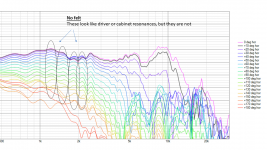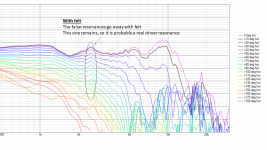Since you appear to be very into this, perhaps you can point to some of these documents? Just saw post askin same question."I suspect tilting back speakers about measly 10 degrees give or take would positively affect imaging."
Ha! I've had my speakers tilted back about 30 degrees for the past 25 years. Why? Because the upper mids and high end need to get into the room and be part of the reverberant field.
Sorry, I did not read your entire post, nor look at your graphs. No need to - it's well known in the industry that a high quality reverberant field is essential to high quality sound for indoor environments. It's fine that you're exploring this as an amateur, but this has all been researched and documented in the professional literature for many decades.
Got two speaker mono setup running and did simple experiment I document here. This is first time two speaker setup in current livingroom, many years since I have had two speakers so was eager to find out how imaging is with my fine self made speakers I've been putting together few years now. And image was kind of diffuse, disappointment having used to single speaker mono. Speakers were in corners now, about 5 meters or so between.
I quickly found out that moving back and forth on the center normal between speakers gave better image when I was quite close to line between speakers. Moved speakers to another wall, the other one is still in a corner and the other about midway of the wall, its open area livinroom / kitchen space, there is practically these two possibilities for positioning speakers. Now speakers were bit over 3m apart. I should mention the system was at high position, tweeter almost 150cm from floor, listening standing up. I can lower or elevate the system some.
Now a peculiar thing happened with the sound, there was kind of distinct spot, along the center normal, where image came to focus and if I took one step back it went back into somewhat blur. Could go into sound and out of sound with one step, not sure which words should be used but the blur went away from the phantom center image and more of an envelopment happened, like sound field being in front of me and then stepping into it, literally inside a bubble or something. This is the sound in the bubblen I'd like to have, but it was again quite close to line between speakers, too close to television in between. 3 meter listening distance is what I've been simulating with and would like to have but not sure if its possible with these, yet.
Measured distance from the blurry/clear image transition spot to each speaker, or where the sound was perveived to liking, and it was quite close to 2 meters. Figured out I should bring speakers closer together and try stereo triangle closer to 2 than 3 meters. Well, got speaker closer together and tried to find the bubble edge spot again, on center normal between the speakers. Eyes closed back and forth and stopped as far away from the speakers as image/sound still seemed to be strong enough to my liking. Any further and it went diffuse. Now, this spot was again quite exactly 2 meters from each speaker, but of course bit further out in the room as speakers were closer to each other now, wtf.
Might be accident or hasty conclusion but to me this indicates that vertical reflections, along with directivity / vertical off-axis response, would affect the result at least some. I mean speaker and listening position changed in relation to all other room boundaries but ceiling and floor. The speakers and vertical reflections did not change between the few positions.
Well, tried to pull the speakers out from frontwall as well ( these are designed to be positioned at the wall ) and similar thing still seemed to happen, about 2m from each speaker there is edge of "sound bubble", moves with the speakers and position in relation to walls didn't seem to change this.
Whats the bubble? it could be just that there low mids or some other boundary effect was at play, less masking or something. I was almost on axis as well as designed toe-in is 45 degrees. A moment of clarity.
I quickly found out that moving back and forth on the center normal between speakers gave better image when I was quite close to line between speakers. Moved speakers to another wall, the other one is still in a corner and the other about midway of the wall, its open area livinroom / kitchen space, there is practically these two possibilities for positioning speakers. Now speakers were bit over 3m apart. I should mention the system was at high position, tweeter almost 150cm from floor, listening standing up. I can lower or elevate the system some.
Now a peculiar thing happened with the sound, there was kind of distinct spot, along the center normal, where image came to focus and if I took one step back it went back into somewhat blur. Could go into sound and out of sound with one step, not sure which words should be used but the blur went away from the phantom center image and more of an envelopment happened, like sound field being in front of me and then stepping into it, literally inside a bubble or something. This is the sound in the bubblen I'd like to have, but it was again quite close to line between speakers, too close to television in between. 3 meter listening distance is what I've been simulating with and would like to have but not sure if its possible with these, yet.
Measured distance from the blurry/clear image transition spot to each speaker, or where the sound was perveived to liking, and it was quite close to 2 meters. Figured out I should bring speakers closer together and try stereo triangle closer to 2 than 3 meters. Well, got speaker closer together and tried to find the bubble edge spot again, on center normal between the speakers. Eyes closed back and forth and stopped as far away from the speakers as image/sound still seemed to be strong enough to my liking. Any further and it went diffuse. Now, this spot was again quite exactly 2 meters from each speaker, but of course bit further out in the room as speakers were closer to each other now, wtf.
Might be accident or hasty conclusion but to me this indicates that vertical reflections, along with directivity / vertical off-axis response, would affect the result at least some. I mean speaker and listening position changed in relation to all other room boundaries but ceiling and floor. The speakers and vertical reflections did not change between the few positions.
Well, tried to pull the speakers out from frontwall as well ( these are designed to be positioned at the wall ) and similar thing still seemed to happen, about 2m from each speaker there is edge of "sound bubble", moves with the speakers and position in relation to walls didn't seem to change this.
Whats the bubble? it could be just that there low mids or some other boundary effect was at play, less masking or something. I was almost on axis as well as designed toe-in is 45 degrees. A moment of clarity.
Then tried to figure out what the bubble was, closely listening to pink noise, which I used along with some music for the previous tests, I then realized not all of the spectrum was on the phantom center, some high frequencies localized to each speaker while this bulk blob was on the middle. I'm not sure what attributes to this but I suspect the compression drivers I use have something going on in the top (yes there is breakup and other issues), or the wavelength is just too short so that this would happen with any tweeters I don't know, but the sound probably does not correlate between the two speakers and no phantom image for the very highs happen. I could make very solid phantom image just by EQ:ing some of the top out, dip on 11kHz lowered the tizz and removed speaker localization, now got solid phantom image. This might also be function of the waveguide as there is sort of diffraction slot type of thing going on, throat angle doesn't match with the driver and what not. Wavelength is close to ~1" where problems start due to physics and probably bit past that I don't hear that well anymore 😀 Try and listen pink noise in mono with your setup, see if you can localize all the spectrum to phantom center or does some parts, like very highs, localize to your speakers? Speakers should sound like almost silent, disappear, all sound should ideally appear to come from front, center in between the speakers, when the sound correlates good and brain processes good phantom image.
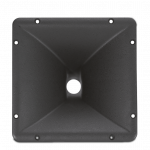
Anyway, now the EQ in place image was more solid but I was stupid and did not do the bubble tests again if the bubble edge now was moved further out or perhaps removed. Dropped the speakers to low position, tweeter around 90cm high and listening seated. Now there doesn't seem to be such radical bubble effect anymore but there is point where better focus to center image emerges. Not sure if this is due to lower listening position or the EQ or both.
All this might have been just balance issue, I have to try this again when I get new electronics system running and long enough cables to tune the DSP from listening spot. If I can make the center focus at listening position, ~3m away from speakers, with just making the top end balance (also new waveguides ordered) and find out if there is some low mid issue masking things, boundary interference or something. The other option is that ceiling reflection affects so much so that when path length through ceiling is short it shortens the listening distance as well, before image getting blurry. In both low and high listening positions either ceiling or floor bounce got to ~5ms at listening distance where there seems to be more "clarity", the sound bubble.
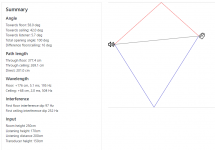
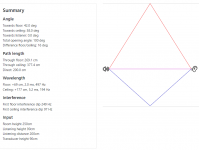
The thing with high speaker/listening position was the increased c-c gave very good simulated boundary interference, almost flat through the 200-1kHz zone, but sound seated was kind of not so good, standing up very good. Also, did not try tilting speakers in these experiments.
Well, anyway, some fun time on the weekend 🙂

Anyway, now the EQ in place image was more solid but I was stupid and did not do the bubble tests again if the bubble edge now was moved further out or perhaps removed. Dropped the speakers to low position, tweeter around 90cm high and listening seated. Now there doesn't seem to be such radical bubble effect anymore but there is point where better focus to center image emerges. Not sure if this is due to lower listening position or the EQ or both.
All this might have been just balance issue, I have to try this again when I get new electronics system running and long enough cables to tune the DSP from listening spot. If I can make the center focus at listening position, ~3m away from speakers, with just making the top end balance (also new waveguides ordered) and find out if there is some low mid issue masking things, boundary interference or something. The other option is that ceiling reflection affects so much so that when path length through ceiling is short it shortens the listening distance as well, before image getting blurry. In both low and high listening positions either ceiling or floor bounce got to ~5ms at listening distance where there seems to be more "clarity", the sound bubble.


The thing with high speaker/listening position was the increased c-c gave very good simulated boundary interference, almost flat through the 200-1kHz zone, but sound seated was kind of not so good, standing up very good. Also, did not try tilting speakers in these experiments.
Well, anyway, some fun time on the weekend 🙂
Last edited:
scaning your posts i immedeately thought about findings of Griesinger. Basically the spl ratio between direct and reflections. Similar to my findings 2y ago, and a change of a few decibels can make the difference. In my case the midrange.
exactly, I'm not sure how the perceived sound relates to all kinds of concepts in papers and written word in forums but yes Griesingers proximity could be same or similar thing I think. Stepping into "bubble" feels like there is enough proximity, and stepping out feels there is too little.
Still, not sure how to affect it, this could be function of the boundaries or perhaps even balance issue, although changing toe in didn't feel it would have affected distance to speaker where proximity happens, even though it adjusts high frequencies to listening position, so I suspect its about the ratio of direct/reflected sound. Anyway, could be multiple things so just speculating. I found it very interesting how easy it was to hear, the transition inside/outside "bubble", or balanced proximity. Well, need to experiment again with new waveguides to see if the top octave sounds better and perhaps correlate better, for one. Then investigate the toe in stuff again if it affects the bubble. Goal is try to extend the bubble further, to practical listening position. This could mean line arrays.... well, lets hope not necessarily 🙂
And yeah I think the bubble is midtange thing mostly, I mean the vocals for example, are the one that gets veiled, not sure if much happens for low mids or very highs. Highs were localizing to speakers and I dropped them some. A blur or a veil, for mids it is, roughly.
Still, not sure how to affect it, this could be function of the boundaries or perhaps even balance issue, although changing toe in didn't feel it would have affected distance to speaker where proximity happens, even though it adjusts high frequencies to listening position, so I suspect its about the ratio of direct/reflected sound. Anyway, could be multiple things so just speculating. I found it very interesting how easy it was to hear, the transition inside/outside "bubble", or balanced proximity. Well, need to experiment again with new waveguides to see if the top octave sounds better and perhaps correlate better, for one. Then investigate the toe in stuff again if it affects the bubble. Goal is try to extend the bubble further, to practical listening position. This could mean line arrays.... well, lets hope not necessarily 🙂
And yeah I think the bubble is midtange thing mostly, I mean the vocals for example, are the one that gets veiled, not sure if much happens for low mids or very highs. Highs were localizing to speakers and I dropped them some. A blur or a veil, for mids it is, roughly.
Last edited:
For interest here is simulated response for these positions. Speaker in "high" position, responses both standing and seated, with 3m and 2m distance. Same for speaker in low position, standing and seated for 3 and 2m distances. There is some difference in responses and first look common thing with all these is that moving from 3m to 2m distance the "in-room" estimate, orange line in Power&DI window which includes first reflections of front wall, side wall, floor and ceiling, interference reduces on the mids and highs. This just means that there is less sound toward first reflections, amount of interference is less in magnitude. This is due to with shorter listening distance angles towards first specular reflections change. Vertical ones increase, while the lateral ones decrease. This means somewhat less sound towards at least the vertical reflections. Horizontal reflections would stay roughly similar or get even louder I think, although I forgot to adjust toe in for the change in listening distance in the simulation to reflect reality, well.. anyway, close enuf for now.
Seated
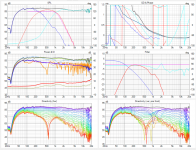
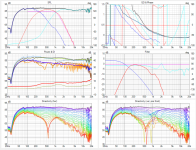
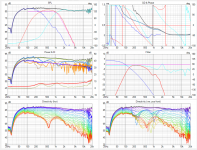
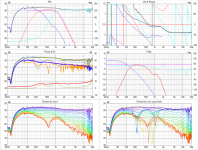
Standing up
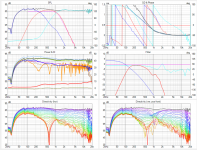
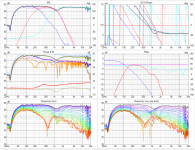
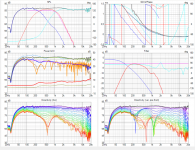
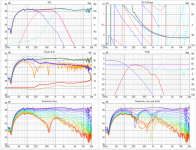
Standing up, high position, 2m was my favourite, great dip on the low mids in the estimated in-room response 😀 can't complain with the low positions either. Well, I think I need to get balance right and figure out how to test the proximity stuff while keeping balance correct.
Seated




Standing up




Standing up, high position, 2m was my favourite, great dip on the low mids in the estimated in-room response 😀 can't complain with the low positions either. Well, I think I need to get balance right and figure out how to test the proximity stuff while keeping balance correct.
Last edited:
What kind of a system do you have and what didbyou end up doing, got the proximity?scaning your posts i immedeately thought about findings of Griesinger. Basically the spl ratio between direct and reflections. Similar to my findings 2y ago, and a change of a few decibels can make the difference. In my case the midrange.
Hi tmuikku, although my plan is to present my doings in a separate thread starting in September, i provide some info here and now.
In short, my system designed and built in 2006, it is a WWMT with Scanspeak 8" woofers, accuton c2-6-78 mid and accuton c30-6-24 tweeter, height some 110cm. Due to other priorities i stopped spending time on speaker design and thus some unfinished work on my speakers.
Current set up in living-room (quite assymetric ;-)):

A couple of years ago i started to look into this matter again, studied the publications on the subject (toole, griesinger, Johnston,, diyaudio.com, etc) and
played with 6mm felt sheets to reduce the unwanted diffraction effects, not much improvement.
Last year just as a "just do it" step i took some absorption panel (cotton, shredded jeans, very difficult to cut), and quickly made something and put it on the speakers.
Some difference!, most striking was the timbre of voices, instruments, stayed much more constant across the room, also more involvement.

So i got intrigued, and this spring re-assembled measurement rigs, made a turntable, and together with Arta and VituixCAD started to get experienced again in measuring and analysis. This time also polar responses. Just before summer i got some reliable measurements done.
Here measurements of mid with Felt:

And here mid without Felt:

The differences are not night and day at first sight, but very promising. Quite a clean up of diffraction effects, more directive, but also an interference on-axis of the rather coarse cut hole in the felt.
Note: i did not suppress the floor and ceiling reflection, something to do in the september planned measurement sessions.
Here tweeter with felt (no measurment saved for case without felt , bummer):
 <photo5>
<photo5>
Using VituixCAD i used on-axis measurements of woofers (from my archive) to get an simulated off-axis response, and combined with the current cross-over and the measured off-axis responses of mid and tweeter, get a simulation of the system polar response. In VituixCAD also the room placement of speaker and LP configured.
Primarely to learn VituisCAD and have a more complete starting point for the upcoming upgrade efforts.
With felt on Mid and teeter

Without felt on mid (with felt on tweeter)

Preliminary findings: given the observed difference, i expected a larger difference in measurements. This reminded me of a Griesinger study outcome, that small (as measured) changes can have more than subtle effect in what we hear/perceive. So it is also the reason i follow your thread with great interest.
In short, my system designed and built in 2006, it is a WWMT with Scanspeak 8" woofers, accuton c2-6-78 mid and accuton c30-6-24 tweeter, height some 110cm. Due to other priorities i stopped spending time on speaker design and thus some unfinished work on my speakers.
Current set up in living-room (quite assymetric ;-)):
A couple of years ago i started to look into this matter again, studied the publications on the subject (toole, griesinger, Johnston,, diyaudio.com, etc) and
played with 6mm felt sheets to reduce the unwanted diffraction effects, not much improvement.
Last year just as a "just do it" step i took some absorption panel (cotton, shredded jeans, very difficult to cut), and quickly made something and put it on the speakers.
Some difference!, most striking was the timbre of voices, instruments, stayed much more constant across the room, also more involvement.
So i got intrigued, and this spring re-assembled measurement rigs, made a turntable, and together with Arta and VituixCAD started to get experienced again in measuring and analysis. This time also polar responses. Just before summer i got some reliable measurements done.
Here measurements of mid with Felt:
And here mid without Felt:
The differences are not night and day at first sight, but very promising. Quite a clean up of diffraction effects, more directive, but also an interference on-axis of the rather coarse cut hole in the felt.
Note: i did not suppress the floor and ceiling reflection, something to do in the september planned measurement sessions.
Here tweeter with felt (no measurment saved for case without felt , bummer):
Using VituixCAD i used on-axis measurements of woofers (from my archive) to get an simulated off-axis response, and combined with the current cross-over and the measured off-axis responses of mid and tweeter, get a simulation of the system polar response. In VituixCAD also the room placement of speaker and LP configured.
Primarely to learn VituisCAD and have a more complete starting point for the upcoming upgrade efforts.
With felt on Mid and teeter
Without felt on mid (with felt on tweeter)
Preliminary findings: given the observed difference, i expected a larger difference in measurements. This reminded me of a Griesinger study outcome, that small (as measured) changes can have more than subtle effect in what we hear/perceive. So it is also the reason i follow your thread with great interest.
Attachments
Nice, cozy looking place and fine looking speakers 🙂 Thanks for posting results with felt, there is definitely a difference noticeable. Although small differences in frequency response the diffraction is mostly time domain thing, delayed sound, so probably audible difference yes.
Need to look more closely later, but now noticed on quick climpse there seems to be some DC error in your measurements, rising response towards 20Hz. There is a fix in VCAD I think, "fix DC error" checkbox or something in Convert IR to FR tool if I remember.
I had this error too with RME babyface and physical cable in reference channel for the dual channel measurement setup. There seems to be some DC on the outputs thats then referenced to the measurements. Check out if your soundcard has some internal loopback available (in the control software). I think this is in the device PCB, at least in RME, so that USB timing errors are still accounted with the loopback reference, at least it looks like so. Well, at least measurements seem to be consistent with the internal loopback and no DC error.
Need to look more closely later, but now noticed on quick climpse there seems to be some DC error in your measurements, rising response towards 20Hz. There is a fix in VCAD I think, "fix DC error" checkbox or something in Convert IR to FR tool if I remember.
I had this error too with RME babyface and physical cable in reference channel for the dual channel measurement setup. There seems to be some DC on the outputs thats then referenced to the measurements. Check out if your soundcard has some internal loopback available (in the control software). I think this is in the device PCB, at least in RME, so that USB timing errors are still accounted with the loopback reference, at least it looks like so. Well, at least measurements seem to be consistent with the internal loopback and no DC error.
Last edited:
Second look on your post: that thick felt worked pretty nice to eliminate diffraction related secondary sound source, almost no interference in the frequency responses anymore so it must be attenuated quite much, especially towards off-axis. Edge diffraction affects off-axis response on opposite side of the edge, diffraction related back wave from left edge affects response right of the speaker. Towards left the left edge diffraction travels along the direct sound but right it has delay of baffle width (more accurately path length from driver to left edge and back). Reasoning from this the felt should be super effective to sides as sound goes roundtrip within and little bit less effective to on-axis, although very good improvement there as well.
Notice how on the whole system simulation you now have on-axis droop around 1-2kHz with the felt, no more diffraction related boost on-axis, or narrowing, how you want to think about it. There is probably droop in power response (before and after) and now you can balance it out better since on-axis response follows power response better, if you wish. You should see this and many other things having taken measurements from all around and having access to power response for example. I suspect lots of fun time ahead figuring out how the graphs relate to sound and if you do changes in crossover or the box was it for better or for worse (in relation to graphs again) 🙂
Nice that you have described the perceived difference as well, although magnitude of changes in frequency response is ~1db it seems that you clearly noticed a difference as you think this would be worthwhile upgrade, to reduce edge diffraction. Did you compare modified and unmodified speaker side by side in mono?
Notice how on the whole system simulation you now have on-axis droop around 1-2kHz with the felt, no more diffraction related boost on-axis, or narrowing, how you want to think about it. There is probably droop in power response (before and after) and now you can balance it out better since on-axis response follows power response better, if you wish. You should see this and many other things having taken measurements from all around and having access to power response for example. I suspect lots of fun time ahead figuring out how the graphs relate to sound and if you do changes in crossover or the box was it for better or for worse (in relation to graphs again) 🙂
Nice that you have described the perceived difference as well, although magnitude of changes in frequency response is ~1db it seems that you clearly noticed a difference as you think this would be worthwhile upgrade, to reduce edge diffraction. Did you compare modified and unmodified speaker side by side in mono?
So i got intrigued, and this spring re-assembled measurement rigs, made a turntable, and together with Arta and VituixCAD started to get experienced again in measuring and analysis. This time also polar responses. Just before summer i got some reliable measurements done.
Here measurements of mid with Felt:
It is interesting that the no-felt measurements show what appears to be resonances between 1k and 2.5k, and resonances in this range are almost always driver resonances... however, adding felt eliminates these "resonances", which means they were not driver resonances (or cabinet resonances) at all, but diffraction effects. We usually assume that a frequency response bump or dip which persists to well off-axis angles is not diffraction, but in this case it is.
Or could it be that the diffraction second source is actually causing an acoustic resonance? @HeadShake showed me CSD data about a year ago where he was measuring stored energy that seemed to be related to diffraction, and his baffle treatment experiments seemed to eliminate it.
I am not sure what is going on here. I am not questioning the measurements, I am sure they are real... I am just wondering what the cause is...
j.
Attachments
Resonances and/or interference , like you Jim i am also pondering about it. In 2 weeks time i will begin measuring again.
Also the relative smooth response from 200 to 1000 with felt is also a observation to be looked into.
Need to solve some DC issue here first, as tmuikku pointed out.
Also the relative smooth response from 200 to 1000 with felt is also a observation to be looked into.
Need to solve some DC issue here first, as tmuikku pointed out.
How long the gating was when you converted IR to FR? The extra undulations could be reflection as they seem to be quite uniform all around, similar interference to all directions inculding back of the box?
I couldn't replicate that kind of pattern with measurements I had available. But perhaps it still is single boundary reflection, lets investigate:
Below is images from a quick test to find the pattern and delay that makes it. It looks like result from ~1.13 meter delayed reflection almost exactly, and on every angle, ~almost 4ms so perhaps its floor or ceiling reflection? Its not probably mic stand as the interference extends below 1kHz so bigger object, like a person or some boundary, perhaps a table or some object bigger than ~50cm that changed place between the sets as it has disappeared from the felt measurements, or the windowing is different. It looks to be roughly ~23db down relative to direct sound so its not probably a hard surface but perhaps a sofa or something. Its not back edge diffraction as it would change with rotation so I suspect something else, perhaps you already know it what it might be?😀
Here is how to generate interference pattern, two ideal sources and delay + attenuation on the other to see the pattern.
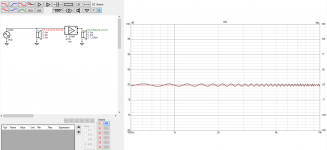
and here overlaid to the results Hifijim quoted above, good match between ~700-2kHz where it is mostly visible. It looks to match the pattern nicely, so delay is found and perhaps culprit is also found. Its like fingerprint 😀 and looks to be originating from somewhere else than from the speaker itself, from the environment / measurement setup.
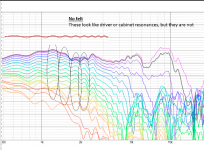 a
a
Below is images from a quick test to find the pattern and delay that makes it. It looks like result from ~1.13 meter delayed reflection almost exactly, and on every angle, ~almost 4ms so perhaps its floor or ceiling reflection? Its not probably mic stand as the interference extends below 1kHz so bigger object, like a person or some boundary, perhaps a table or some object bigger than ~50cm that changed place between the sets as it has disappeared from the felt measurements, or the windowing is different. It looks to be roughly ~23db down relative to direct sound so its not probably a hard surface but perhaps a sofa or something. Its not back edge diffraction as it would change with rotation so I suspect something else, perhaps you already know it what it might be?😀
Here is how to generate interference pattern, two ideal sources and delay + attenuation on the other to see the pattern.

and here overlaid to the results Hifijim quoted above, good match between ~700-2kHz where it is mostly visible. It looks to match the pattern nicely, so delay is found and perhaps culprit is also found. Its like fingerprint 😀 and looks to be originating from somewhere else than from the speaker itself, from the environment / measurement setup.
 a
a
Last edited:
Back to reflections, found cool text about hearing system https://www.thebroadcastbridge.com/...logy-part-2-the-time-domain-and-human-hearing
Thank you for this masterclass in using VituixCAD. I was already trying to figure out what could cause the issues i saw.I couldn't replicate that kind of pattern with measurements I had available. But perhaps it still is single boundary reflection, lets investigate:
Below is images from a quick test to find the pattern and delay that makes it. It looks like result from ~1.13 meter delayed reflection almost exactly, and on every angle, ~almost 4ms so perhaps its floor or ceiling reflection? Its not probably mic stand as the interference extends below 1kHz so bigger object, like a person or some boundary, perhaps a table or some object bigger than ~50cm that changed place between the sets as it has disappeared from the felt measurements, or the windowing is different. It looks to be roughly ~23db down relative to direct sound so its not probably a hard surface but perhaps a sofa or something. Its not back edge diffraction as it would change with rotation so I suspect something else, perhaps you already know it what it might be?😀
Here is how to generate interference pattern, two ideal sources and delay + attenuation on the other to see the pattern.
View attachment 1082073
and here overlaid to the results Hifijim quoted above, good match between ~700-2kHz where it is mostly visible. It looks to match the pattern nicely, so delay is found and perhaps culprit is also found. Its like fingerprint 😀 and looks to be originating from somewhere else than from the speaker itself, from the environment / measurement setup.
View attachment 1082075a
More masterful would have been to include attenuation from path length of the reflection in the associated commentary 😀 Well, -23db attenuation + attenuation of path length makes the interference be within about 1db, about the same as in your measurements. Semantics though, big hard surface would attenuate few db only and would show up serious interference so this is some seriously attenuated delayed sound in your measurement. Small / soft object, perhaps both, or something.
Please, if you find the source, comment what it was as I'm just reasoning and speculating upon the data and observations. Would be valuable info for all in case similar thing appears on anyones measurements.
Please, if you find the source, comment what it was as I'm just reasoning and speculating upon the data and observations. Would be valuable info for all in case similar thing appears on anyones measurements.
It is the edge of the baffle, which is 13,15 cm from the center of the driver. So in essence the absorption felt works for reducing significantly the baffle diffraction effect.I couldn't replicate that kind of pattern with measurements I had available. But perhaps it still is single boundary reflection, lets investigate:
Below is images from a quick test to find the pattern and delay that makes it. It looks like result from ~1.13 meter delayed reflection almost exactly, and on every angle, ~almost 4ms so perhaps its floor or ceiling reflection? Its not probably mic stand as the interference extends below 1kHz so bigger object, like a person or some boundary, perhaps a table or some object bigger than ~50cm that changed place between the sets as it has disappeared from the felt measurements, or the windowing is different. It looks to be roughly ~23db down relative to direct sound so its not probably a hard surface but perhaps a sofa or something. Its not back edge diffraction as it would change with rotation so I suspect something else, perhaps you already know it what it might be?😀
Here is how to generate interference pattern, two ideal sources and delay + attenuation on the other to see the pattern.
View attachment 1082073
and here overlaid to the results Hifijim quoted above, good match between ~700-2kHz where it is mostly visible. It looks to match the pattern nicely, so delay is found and perhaps culprit is also found. Its like fingerprint 😀 and looks to be originating from somewhere else than from the speaker itself, from the environment / measurement setup.
View attachment 1082075a
Still to work on is the dip at around 1800 Hz, and the apparent resonance in the 2-3 KHz region.
I will start a separate thread , so not to interfere with this thread. Thanks Jim and Tmuikku ;-)
I think its not edge diffraction, delay is 1,13m so 113cm, tenfold distance to edge. It is path length difference so in addition to path length from DUT to mic. This is in range of path length difference for a floor/ceiling bounce with speaker roughly mid way of the room height in typical european home and microphone 1m away from speaker. Basically some object ~1m to side, up or down, of the DUT while measuring.
Attached is demonstration of 1.2m path length difference from floor. Did you have pillows/mattress on the floor between mic and dut, and DUT and mic about 1 meter above it? might be it an dperhaps shortening window when you convert IR to FR could get rid of the reflection.
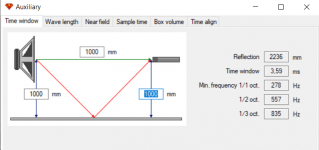
Attached is demonstration of 1.2m path length difference from floor. Did you have pillows/mattress on the floor between mic and dut, and DUT and mic about 1 meter above it? might be it an dperhaps shortening window when you convert IR to FR could get rid of the reflection.

Attached a picture of an old book, actually a copy of a few pages only. much to my regret i ditched the entire dossier about audio i collected in the seventies. This is just saved by accident.Back to reflections, found cool text about hearing system https://www.thebroadcastbridge.com/...logy-part-2-the-time-domain-and-human-hearing
It shows the left-right ability of our hearing, and it is one reason for me for my xo-frequencies.
What is included is the assumption of direct sount only and no time-delays in the 2 speaker system. Which is especially important in the lower frequencies, in that document it was indicated that it must be less than 500usec. Haas (precendence effect) was one of the sources.
- Home
- Loudspeakers
- Multi-Way
- Vertical reflections, symmetric crossover and tilt -experiment

